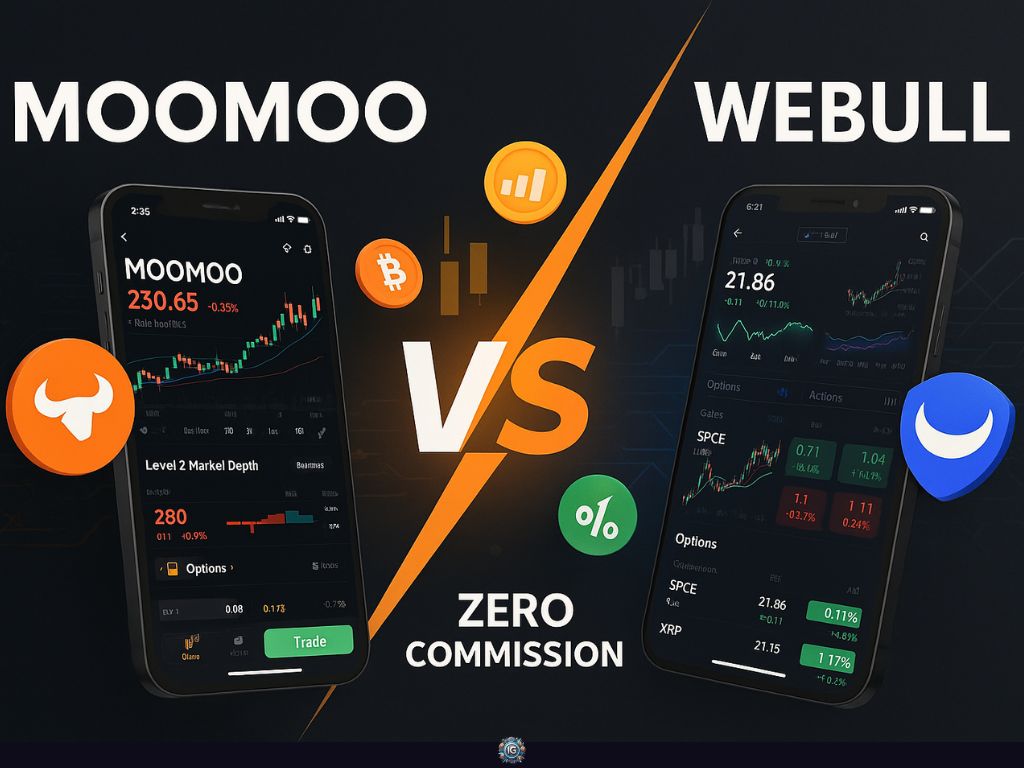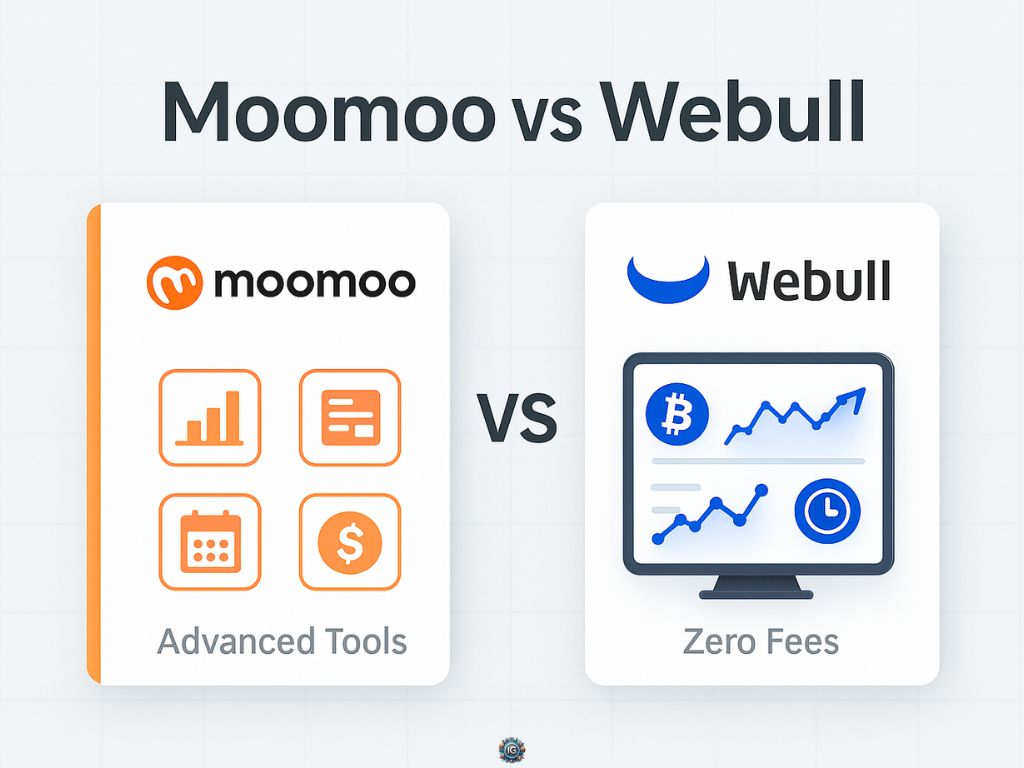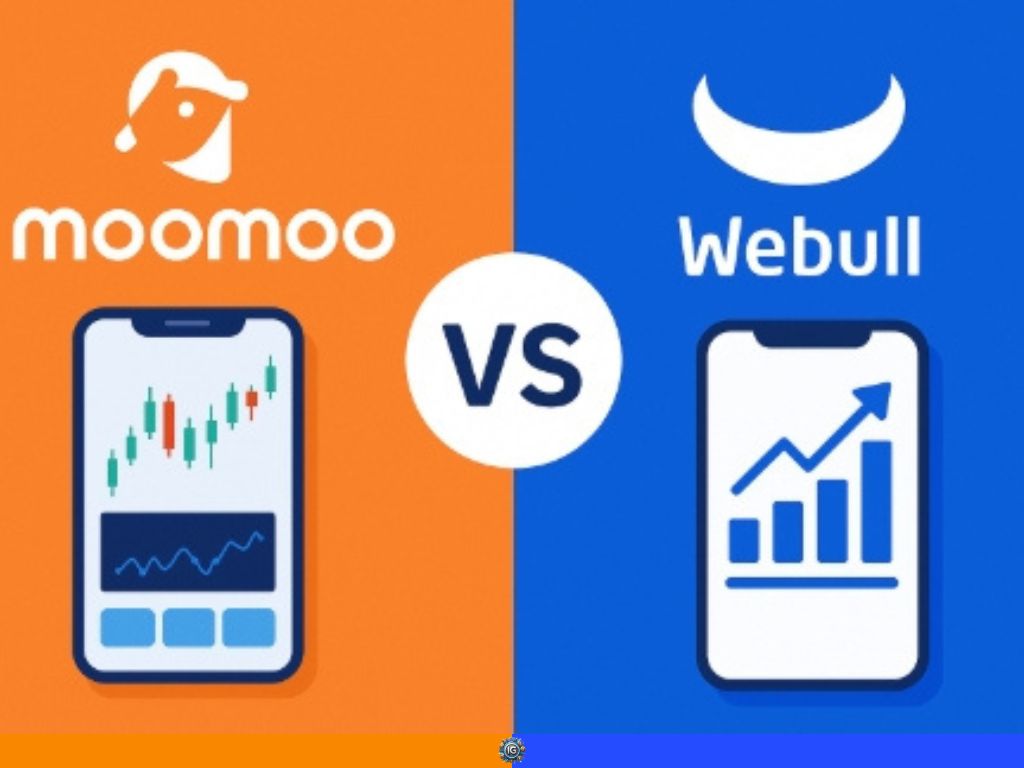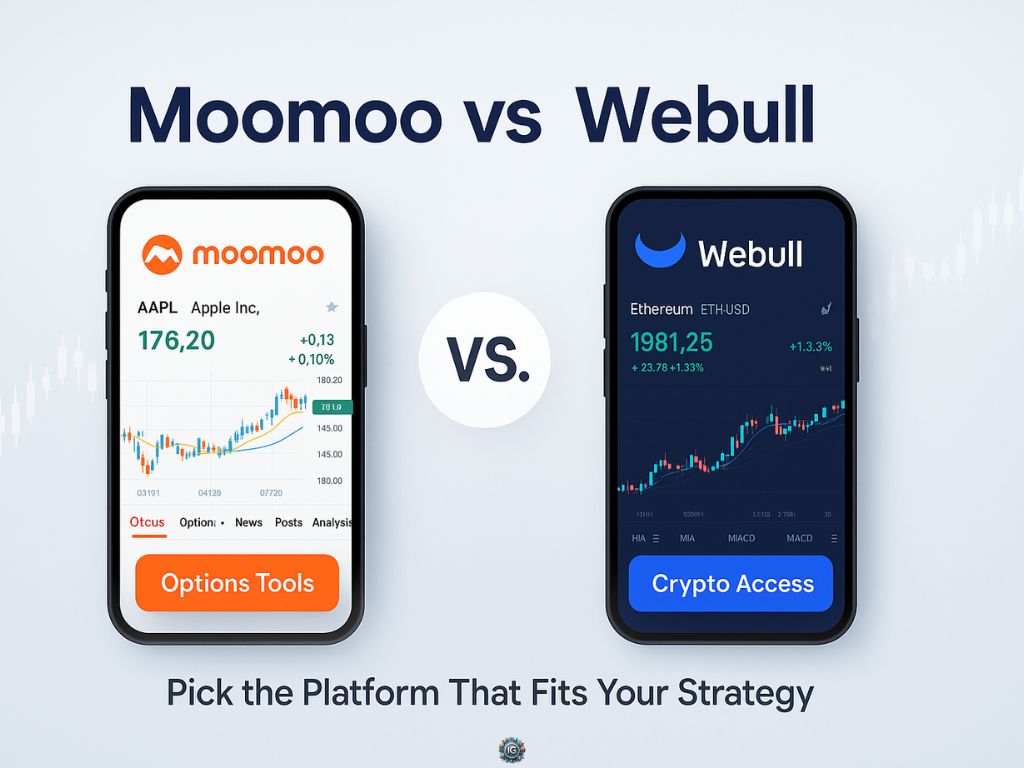Introduction
Moomoo and Webull are two of the most feature-packed commission-free trading platforms available in 2025 — but only one of them is right for you.
At a glance, they seem similar: sleek mobile apps, zero stock trading fees, advanced charts, and access to options, ETFs, and even crypto. But dig deeper, and the differences are clear — in their tools, pricing structures, user experience, and who they’re actually built for.
This guide doesn’t waste time with surface-level comparisons. You’ll get a clear breakdown of where Moomoo beats Webull, where Webull pulls ahead, and which platform wins depending on your trading style, goals, and risk tolerance.
Key Takeaways
- Webull offers a smoother user experience, better crypto support, and is ideal for beginner-to-intermediate U.S. traders.
- Moomoo provides more advanced tools, deeper research, and access to global markets — better suited for data-driven, active investors.
- Both platforms offer commission-free trading on U.S. stocks, ETFs, and options.
- Moomoo has better research and charting, while Webull has better UI and crypto access.
- Neither platform supports mutual funds or advanced automation tools (like conditional orders with scripting).
- Choose Moomoo if you want institutional-level data and don’t mind a steeper learning curve.
- Choose Webull if you want speed, simplicity, and access to both stocks and crypto in one place.
Disclaimer: I am an independent Affiliate. The opinions expressed here are my own and are not official statements. If you follow a link and make a purchase, I may earn a commission.

Platform Overview: Moomoo vs Webull
Moomoo: Institutional Tools for Retail Traders
Moomoo is backed by Futu Holdings, a publicly traded fintech company with ties to Tencent. It’s built for serious retail investors who want Wall Street-grade research, Level 2 market data, and access to U.S., Hong Kong, and China A-shares — all in one platform.
It appeals most to data-driven traders who rely on indicators, earnings calendars, heatmaps, and macroeconomic insight to make informed decisions.
Webull: Streamlined, U.S.-First Trading for the Masses
Webull is a U.S.-based brokerage offering zero-commission trading, options, and crypto from a clean, modern interface. It’s designed for speed, ease of use, and mobile-first investing, with paper trading, stock screening, and extended hours access baked in.
Webull doesn’t overwhelm you with tools — it gives you just enough to trade confidently, without requiring an analyst’s background.
Key Differences at a Glance
| Feature | Moomoo | Webull |
| Parent Company | Futu Holdings (China) | Webull Financial LLC (U.S.) |
| Asset Access | U.S., Hong Kong, China A-shares | U.S. markets only |
| Crypto Support | Limited, indirect | Full crypto trading |
| Target User | Advanced, research-heavy traders | Beginner to intermediate U.S. investors |
| Interface Style | Feature-dense, highly customizable | Clean, minimal, mobile-optimized |
Moomoo aims to be a Bloomberg terminal for retail investors. Webull aims to be Robinhood — but smarter.
Moomoo vs Webull Fees and Pricing: Where Costs Really Add Up
Both Moomoo and Webull advertise $0 commissions on U.S. stock and ETF trades, but that’s just the surface. The real differences show up in options fees, margin interest, and crypto trading costs — and those differences matter depending on how you trade.
Here’s how their fee structures break down in real terms:
1. Stock and ETF Trading
Both platforms offer true zero-commission trading on U.S.-listed stocks and ETFs.
There are no hidden platform fees or order routing charges.
Verdict: No difference — both are cost-effective for basic stock investing.
2. Options Trading
- Moomoo charges $0 per contract — extremely rare in the industry
- Webull charges $0.55 per contract, in line with most U.S. brokerages
Who wins? Moomoo, especially if you trade contracts frequently. Over time, those per-contract fees add up.
3. Margin Interest
If you trade on margin (borrowed money), this is where pricing matters.
- Moomoo’s margin rate starts at 6.8% APR for balances under $25,000
- Webull’s rate starts at 9.74% APR for the same tier
Who wins? Again, Moomoo — the lower margin rate means less drag on leveraged trades.
4. Crypto Trading
- Moomoo does not support direct crypto trading in the U.S.
- Webull offers direct access to Bitcoin, Ethereum, Litecoin, and more, with a 1% markup built into each trade
Who wins? Webull, if you want crypto exposure without switching platforms. Just know that 1% markup is higher than most crypto-native exchanges.
5. Other Fees
- No inactivity fees on either platform
- ACH deposits and withdrawals are free
- Wire transfers incur standard banking fees on both sides
Final Take
| Feature | Winner | Why It Matters |
| Stock/ETF Trading | Tie | Both are commission-free |
| Options Contracts | Moomoo | $0 per contract vs. $0.55 at Webull |
| Margin Interest | Moomoo | Lower APR = cheaper leverage |
| Crypto Access | Webull | Direct trading, though with spread |
| Hidden Fees | Tie | Transparent on both sides |
If you trade options or on margin, Moomoo is the clear cost leader. If you want built-in crypto, Webull is the better fit — but expect to pay for that convenience.
Moomoo vs Webull: User Interface and Experience
The user experience can make or break a trading app — especially for active investors who rely on fast execution, intuitive navigation, and customizable dashboards. While both Moomoo and Webull offer modern, well-designed interfaces, they serve different user priorities.
Moomoo: Feature-Rich, But Cluttered for Beginners
Moomoo is built for information density. Its interface emphasizes advanced charting, fundamental research, analyst ratings, and macroeconomic data — all within a multi-tab workspace.
Pros:
- Deep customization (indicators, data layouts, themes)
- Built-in earnings calendars, global market heatmaps
- Feels more like a Bloomberg terminal than a mobile app
Cons:
- Steeper learning curve
- May feel overwhelming for casual or first-time investors
Moomoo is built for traders who want to see everything at once — not for those who want simplicity.
Webull: Sleek, Streamlined, and Mobile-First
Webull focuses on a clean, responsive design that works equally well on desktop and mobile. It delivers key tools — charting, order flow, screeners — without crowding the screen.
Pros:
- Easier to navigate out of the box
- Highly rated mobile app (iOS & Android)
- Fast trade execution with intuitive workflows
Cons:
- Fewer customization options
- Less built-in market data and research depth
Webull strikes a better balance for traders who want speed, simplicity, and access — without sacrificing core functionality.
Final Verdict on UX
- Choose Moomoo if you’re a power user who values raw data, rich visuals, and deep analysis
- Choose Webull if you want fast navigation, better mobile experience, and a gentler learning curve

Moomoo vs Webull: Features and Tools
While both Moomoo and Webull support core trading functions like stocks, ETFs, and options, the real difference lies in how deep their tools go — and who they’re designed to serve.
Charting and Technical Analysis
Moomoo
- Offers professional-level charting with over 60 indicators, multiple timeframes, and drawing tools
- Supports multi-window layouts for side-by-side comparisons
- Includes real-time Level 2 market data (free for some accounts) and visual order books
- Advanced tools like backtesting, short interest tracking, and institutional flow
Webull
- Strong charting with 50+ indicators, clean UI, and mobile-friendly views
- Supports basic to intermediate technical analysis, but fewer pro-level data overlays
- Offers Level 2 data via subscription (usually around $1.99/month)
Verdict: Moomoo wins for depth and customization. Webull wins for usability and simplicity.
Paper Trading
Both platforms offer free paper trading accounts with real-time market data.
- Moomoo: More detailed simulation environment, tied to its data-rich toolset
- Webull: Easier to launch and operate for beginners, directly accessible in the mobile app
Verdict: Tie — but beginners may prefer Webull’s smoother setup.
Research and News
Moomoo
- Institutional-grade data: earnings reports, analyst ratings, ETF breakdowns, SEC filings
- Global news feeds and macro-level dashboards
- Integration with AI-based sentiment scoring
Webull
- Solid news coverage and analyst insights
- Earnings calendar, watchlist alerts, and customizable notifications
- Simpler interface, but fewer layers of deep research
Verdict: Moomoo is built for traders who research every angle. Webull offers just enough to take action without overwhelming users.
Educational Content
- Moomoo: In-depth tutorials, webinars, and strategy explainers — mostly geared toward intermediate and advanced users
- Webull: Beginner-friendly blog posts, walkthroughs, and video guides
Verdict: Webull is better for beginners. Moomoo offers more once you level up.
Bottom Line
If you want advanced tools that mimic professional terminals, Moomoo delivers more horsepower. If you want just the essentials — with enough to execute confidently — Webull is cleaner and more accessible.

Moomoo vs Webull Available Assets: What Can You Trade?
At first glance, Moomoo and Webull appear to offer similar access to core assets like stocks, ETFs, and options. But when you zoom in, their differences — especially in international markets and crypto support — become more apparent.
U.S. Stocks and ETFs
Both platforms offer full access to U.S.-listed stocks and ETFs, with commission-free trading and extended hours support.
Verdict: Tie
Options
Both apps support options trading with multi-leg strategies like spreads and straddles.
- Moomoo charges $0 per contract
- Webull charges $0.55 per contract
Verdict: Moomoo wins on cost, but both offer solid tools for casual options traders
Fractional Shares
- Webull supports fractional share investing on select U.S. stocks, letting users invest with as little as $5
- Moomoo does not currently support fractional shares
Verdict: Webull wins — better for small balance investors or dollar-cost averaging
Crypto
- Webull allows direct crypto trading (BTC, ETH, LTC, DOGE, and more) within the app
- Moomoo offers no direct crypto access for U.S. users
Verdict: Webull wins — ideal for those who want both equities and crypto in one place
International Markets
- Moomoo provides access to Hong Kong stocks and China A-shares, making it a standout for global investors
- Webull is focused exclusively on U.S. markets
Verdict: Moomoo wins for international access
Mutual Funds, Bonds, Futures
- Neither platform supports mutual funds, bonds, or futures contracts
- Both are strictly focused on self-directed trading in equities, options, and (in Webull’s case) crypto
Summary Comparison
| Asset Class | Moomoo | Webull |
| U.S. Stocks/ETFs | ✅ Yes | ✅ Yes |
| Options | ✅ Yes ($0/contract) | ✅ Yes ($0.55/contract) |
| Fractional Shares | ❌ No | ✅ Yes |
| Crypto | ❌ No | ✅ Yes |
| International Stocks | ✅ Yes (HK, China) | ❌ No |
| Mutual Funds/Futures/Bonds | ❌ No | ❌ No |
Final Word
- Choose Moomoo if you want access to foreign equities and zero-cost options
- Choose Webull if you want to invest in crypto and fractional shares alongside stocks
How Moomoo and Webull Set Themselves Apart
While Moomoo and Webull overlap in many core features, each platform has carved out distinct strengths that appeal to different types of traders. These differences become especially important when your priorities go beyond “just trading stocks.”
Here’s where each one stands out:
Moomoo’s Defining Advantages
- Access to International Markets
Moomoo offers trading in Hong Kong stocks and China A-shares, making it one of the few U.S.-accessible platforms for retail investors who want global exposure.
- Institutional-Level Research
With built-in access to analyst ratings, ETF breakdowns, economic calendars, and earnings forecasts, Moomoo delivers a research experience typically found on paid tools.
- Zero-Cost Options Trading
Moomoo charges $0 per contract on options trades, which is rare — and a major cost saver for active traders.
- Advanced Visualization Tools
Heatmaps, capital flow tracking, and in-depth market scanners give data-heavy traders the edge in identifying opportunities quickly.
Webull’s Defining Advantages
- Built-In Crypto Trading
Webull supports direct crypto trading — including Bitcoin, Ethereum, Dogecoin, and more — without needing a separate app.
- Fractional Shares
Webull allows investors to buy partial shares of popular stocks, making it easier to get started with smaller amounts.
- Simpler, More Intuitive UI
Webull’s mobile app is cleaner and easier to navigate, especially for beginners or those who trade casually.
- Easier Onboarding for Beginners
With less complexity and fewer advanced tools upfront, Webull offers a more approachable learning curve.
If you’re looking for data depth and global market access, Moomoo has the edge. If you want crypto, fractional shares, and a cleaner app experience, Webull is the better fit.
Read our Moomoo vs Robinhood comparison here.

Who Should Choose Moomoo — And Who Should Go With Webull
At this point, the differences between Moomoo and Webull are clear — but how do you know which one actually fits your trading style, risk tolerance, and investing goals?
Here’s a straightforward breakdown:
Choose Moomoo If…
- You want to trade international markets like Hong Kong or China A-shares
- You rely on deep research tools, economic indicators, and advanced data overlays
- You trade options frequently and want to avoid per-contract fees
- You’re a self-directed, data-driven investor who prefers control over convenience
- You don’t need crypto or fractional shares in your portfolio
Moomoo is built for retail investors who want an institutional toolkit — not just a trading app.
Choose Webull If…
- You’re focused on U.S. markets, including stocks, ETFs, and options
- You want to trade crypto and equities in the same place
- You’re starting with a smaller portfolio and want fractional shares
- You prefer a clean, mobile-first experience over endless customizations
- You’re newer to investing and want a platform that’s easy to learn quickly
Webull is ideal for traders who value speed, simplicity, and flexibility — especially if crypto is part of your strategy.
In short:
- Choose Moomoo if you want more data, more markets, and more depth.
- Choose Webull if you want an easier entry point, fewer distractions, and built-in crypto.

FAQs About Moomoo and Webull
Are Moomoo and Webull safe to use?
Yes. Both are regulated brokerages and members of FINRA and SIPC. U.S. securities are protected up to $500,000 under SIPC coverage. However, this protection does not apply to cryptocurrency holdings or international assets.
Can I use both platforms at the same time?
Absolutely. Many investors maintain accounts with both — for example, using Moomoo for research and international trading, and Webull for fractional shares or crypto exposure.
Does Moomoo offer access to international markets?
Yes. Moomoo supports trading in Hong Kong stocks and China A-shares, a rare feature among U.S.-accessible platforms.
Is Moomoo good for advanced traders?
Yes. With advanced charting, heatmaps, capital flow tools, and Level 2 market data, Moomoo is ideal for active and research-driven investors.
Does Moomoo charge options contract fees?
No. Moomoo charges $0 per contract on options trades, making it a cost-effective choice for frequent options traders.
Can I trade cryptocurrency on Webull?
Yes. Webull offers 24/7 access to a growing list of cryptocurrencies, including Bitcoin, Ethereum, and Dogecoin, directly within the app.
Does Webull support fractional share investing?
Yes. Investors can buy fractional shares of eligible U.S. stocks, allowing for greater flexibility and lower capital requirements.
Is Webull beginner-friendly?
Yes. Webull’s clean interface, mobile-first design, and simple onboarding process make it accessible to new investors without sacrificing essential tools.

Conclusion: Moomoo vs Webull — Which Should You Choose?
Moomoo and Webull both offer powerful, commission-free trading platforms, but they’re built for different types of investors.
If you want access to international markets, zero-cost options trading, and a deep research toolkit, Moomoo stands out. It’s ideal for serious, data-driven traders who want more than just a sleek interface.
If you’re looking for crypto trading, fractional shares, and a cleaner mobile experience, Webull is the better fit — especially for beginners or casual traders who value speed and simplicity.
In short:
- Choose Moomoo if you’re a research-heavy trader with global ambitions.
- Choose Webull if you’re a U.S.-based investor who wants flexibility, ease of use, and access to crypto in one place.
Still undecided? Open both. Explore the interfaces. Test the tools.
You’ll know which one feels right — and why.
Next: check out our Crypto Trading for Beginners full guide.
For a full comparison with a traditional broker, see Webull vs Fidelity.
2 thoughts on “Moomoo vs Webull: Which Trading App Wins in 2025?”